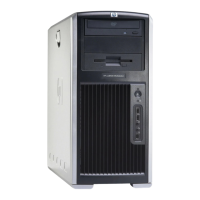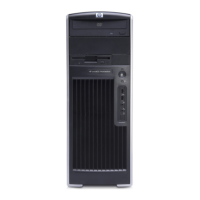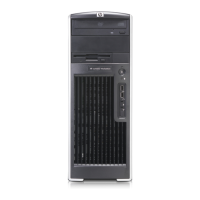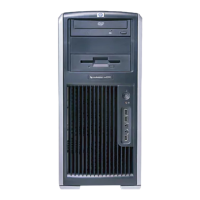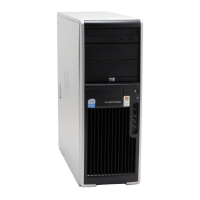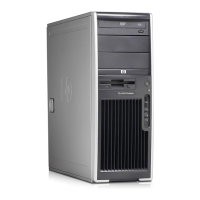Heading Option Description
completes, a list of bootable devices is displayed. Use the arrow keys to select the preferred
bootable device and press Enter. The workstation then boots from the selected non-default device
for this one time.
Security Setup
Password
Allows you to set and enable setup (administrator) password.
NOTE: If the setup password is set, you must enter Computer Setup (F10) Utility to change it,
flash the ROM, and make changes to certain plug-and-play settings under Windows.
Power-On
Password
Allows you to set and enable power-on password.
Password
Options
Lock Legacy Resources
Prevents the operating system from reassigning plug-and-play resources for serial, parallel, and
diskette legacy I/O devices.
Network Server Mode
Enable or disable Network Server Mode, which enables the workstation to boot the operating
system when the power-on password is enabled with or without a keyboard or mouse attached.
When attached to the system, the keyboard and mouse remain locked until the power-on password
is entered.
Password Prompt on Warm Boot
Sets the Password Prompt on Warm Boot function. If disabled, the BIOS will only prompt for a
password after power-on
Smart Cover Allows you to disable cover removal sensor or to notify user if sensor has been activated. If
disabled, the BIOS will only prompt for a password after power-on.
Device Security Makes the following devices available or unavailable to the system:
●
Serial port
●
Parallel port
●
All USB ports
●
Front USB ports
●
System audio
●
Controller security
●
SATA controller security
●
IEEE 1394 controller
●
Network controller
●
Embedded Security Device
For each device, Device available is the default setting and allows the operating system access
to the device. Device Hidden makes the device unavailable; it is disabled by the BIOS and cannot
be enabled by the operating system.
When enabled, Embedded Security Device offers these options:
●
Enable/disable—Turns the TPM on/off.
●
Power-On Authentication Support—Enables/disables an authentication feature that requires
you to enter a TPM user key password to boot the system. This feature uses the TPM to
generate and store the authentication password.
●
Reset Authentication Credential—Resets the authentication functionality and clears all
authentication credentials.
Table 3-1 Computer Setup (F10) Utility menu descriptions (continued)
30 Chapter 3 System management ENWW

